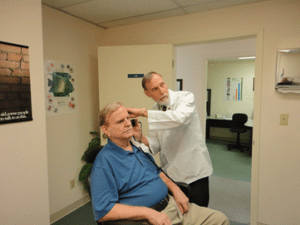
Whether you’re a seasoned wearer of hearing aids or just a beginner, getting your hearing aids cleaned is something that every wearer can struggle with at some point. Can you believe there’s a right and wrong way to go about it, based on your hearing aid of choice? Whether you’re looking for hearing aid cleaning tips or general maintenance advice, you’re in the right place. Here is some helpful information to help keep your hearing aids in tip-top shape.
Cleaning Your Hearing Aids
The cleaning process for hearing aids can depend on whether you have in-the-ear (ITE), receiver-in-the-canal (RIC), or behind-the-ear (BTE) hearing aids. An ITE hearing aid can require a specialized brush to clean away excess wax or dirt. You may also use any sprays or cleaning cloths provided by your hearing care provider for removing dirt in hard-to-reach places.
The cleaning process of RIC aids is very similar but can also require cleaning the dome surface and thin wire with special cleaning wipes recommended by your hearing aid supplier. While cleaning your BTE hearing aids with a brush, you can use the loop on the end of it to pick wax out of the sound outlet.
Changing Your Hearing Aid Filters
Has wax built up in your hearing aid filter? Have you noticed that your hearing loss seems worse because the sound is not as clear as it used to be? It might be time to change your hearing aid filters. Fortunately, the process is relatively straightforward. Use a pen-like tool your hearing care provider gave you to push into the hole at the top of your filter. You can then pull it away.
Inserting a new one is equally as effortless as you can flip over your tool and press a new filter into place. Remember, every hearing aid is different, so consult your user manual for specific brand information.
Changing the Batteries
From time to time, you’ll need to change your hearing aid batteries. Each brand and size of hearing aid will have a different amount of battery life. Deciding how often you can tolerate changing or charging your aids is something you should consider before purchasing. Luckily, guides for the best hearing aids help readers find a brand that is within their budget and has features most important to the user. For most hearing aids, the battery swapping or charging process is designed to be straightforward, but it’s specific to your hearing aid type. Refer to your hearing aid user manual, or talk to your local hearing care expert.
Everyday Maintenance
One of the best ways of getting your hearing aids clean, regardless of the type, is by making sure they don’t get dirty in the first place. Preventative maintenance can be key.
Get into the habit of brushing your hearing aids daily to remove wax from around the microphone and sound outlet areas. In the morning is the best time of the day, as the wax hardens in your hearing aids overnight.
You can also use a cloth to wipe away debris or dirt, but make a point of regularly washing this cloth to avoid contaminants. Most importantly, keep your hearing aids dry. Avoid water, hairspray, and other fluids.
Cleaning and maintaining your hearing aids is one small thing you can do to improve their lifespan. If you need a helping hand for your specific hearing aid type, book an appointment with your local hearing care specialist.